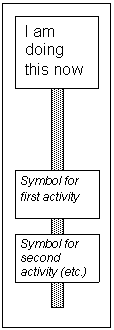User login
Description:
The child will be able to use a visual timetable to help them know what is coming up.
| Early years skill: | Personal, Social and Emotional |
| Early years typical range: | 8-20m |
| P-scales/Curriculum skill: | PSHE and Citizenship |
| P-scales/Curriculum level: | P4 |
| TAP skill: | Social Interaction |
| TAP level: | TAP24 |
| Pre/Nat. Curriculum Area: | not specified |
| Pre/Nat. Curiculum Standard: | not specified |
| Phoenix Area: | not specified |
| Phoenix Step: | not specified |
| Section: | Early Years (0-5yrs) info; Primary (5-11yrs) info |
| Activity/strategy name and materials required | How to do the activity | Key principles for doing the activity and comments | |
|---|---|---|---|
| Using a visual timetable Home made visual timetable with 'finished' box or envelope and Velcro strip. Set of laminated symbols for timetable activities e.g. 'swimming', 'maths', 'carpet time' with scratchy Velcro on the back. You can create symbols cards in PowerPoint with the Commtap Symboliser. | 1. Make a long cardboard strip approximately 10cm wide and 60cm long. Attach a 'FINISHED' box or plastic envelop at the bottom of the strip. 2. Stick a strip of soft Velcro along the centre of the long laminated strip e.g.
3. Arrange symbols of the activities a child will cover for - say - a morning down the Velcro strip. 4. Just before an activity starts help the child put the relevant symbol into the 'I am doing this now' area at the top of the laminated strip. This shows the child what to expect to happen now. 5. When the activity is over help the child remove the symbol for the 'I am doing this now' area and post it into the 'FINISHED' box or envelope. Help the child take the next symbol and put it into the 'I am doing this now' area etc. | This technique helps children understand what is going to happen during the day. Use it with children who are anxious about change or find understanding class routines difficult. It is best to set up a visual timetable before the child comes into school and to set it up for a limited period say from arrival until the first play and then from after play until lunch and then a final set up for the afternoon period. Children sometimes try to alter the timetable to suit themselves e.g. putting play up near the top! This is not allowed! Only the adult in charge can change the order on a visual timetable. If following the set timetable for a given period is very difficult for a child you can make it easier by shortening the time a child must spend on each activity - but each activity must be done a little bit. You can try with just two activities (now/next) see the now/next visual timetable activity below. | |
| Now/next visual timetable "Now /next" visual timetable with 'finished' box or envelope and Velcro strip. Set of laminated photos for timetable activities e.g. 'story', 'outside', 'carpet time' with Velcro on the back. | If the child is resistant to some of the activities it's important to use clear consistent language e.g."first story, then sand". Being able to see a motivating activity coming up may mean that the child is happier to engage in less motivating activities. |
Support Commtap to keep it online
Thank you for visiting Commtap.
Please read this message as it is extremely important.
- Visitor donations mean we can continue to host over 1,000 free activities to support speech, language, and communication development.
- Visitor donations mean we can continue to provide free resources to address a wide range of communication needs, including limited speech or language, interaction challenges, and needs associated with conditions such as developmental language disorder, autism, and cerebral palsy.
- Visitor donations mean we can continue to provide resources to support the work of speech and language therapists, teachers, teaching assistants, parents, and carers.
- Visitor donations mean we can continue to provide the free key word sign dictionary (bks.org.uk) which has over 2,000 Makaton and Signalong signs.
We know that not everyone is able to afford to pay to access these resources, however, if you can, please make a donation to keep the site going.
Thank you
Google ads on this page are provided by Google Adsense - and their presence does not imply any endorsement by Commtap. Report a problem with an ad on this page. Log in (for free) to avoid seeing Google ads.

